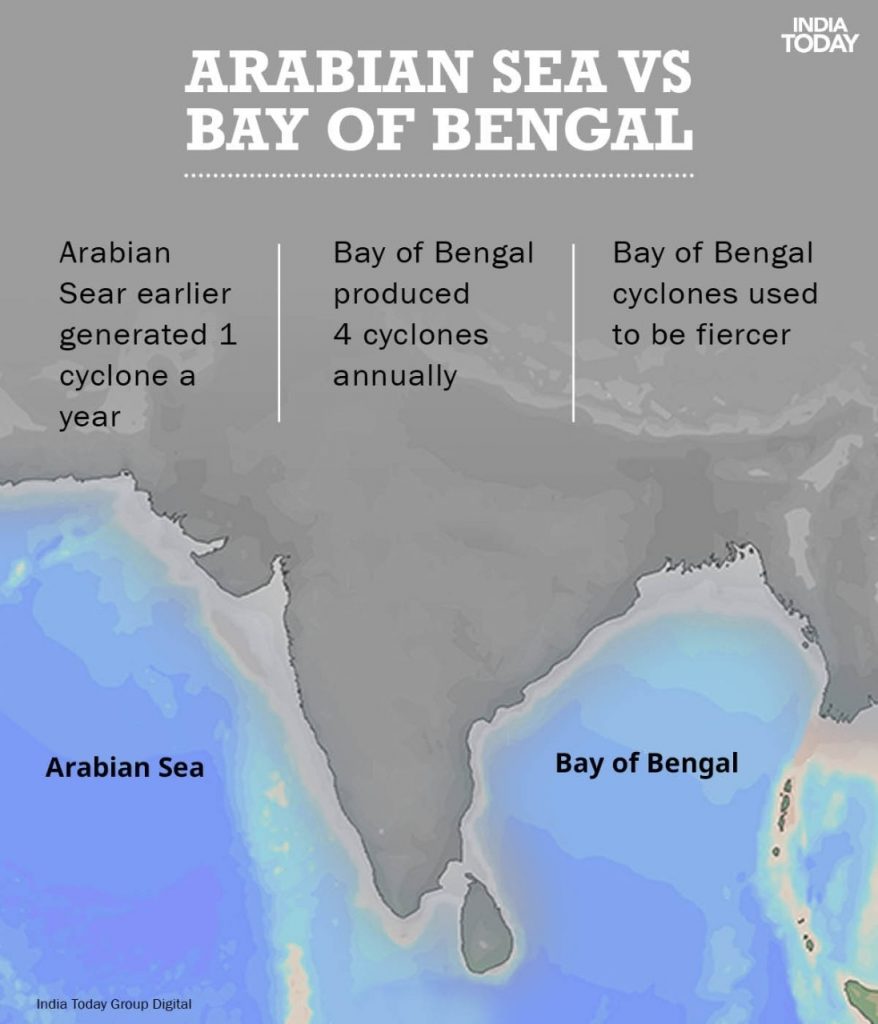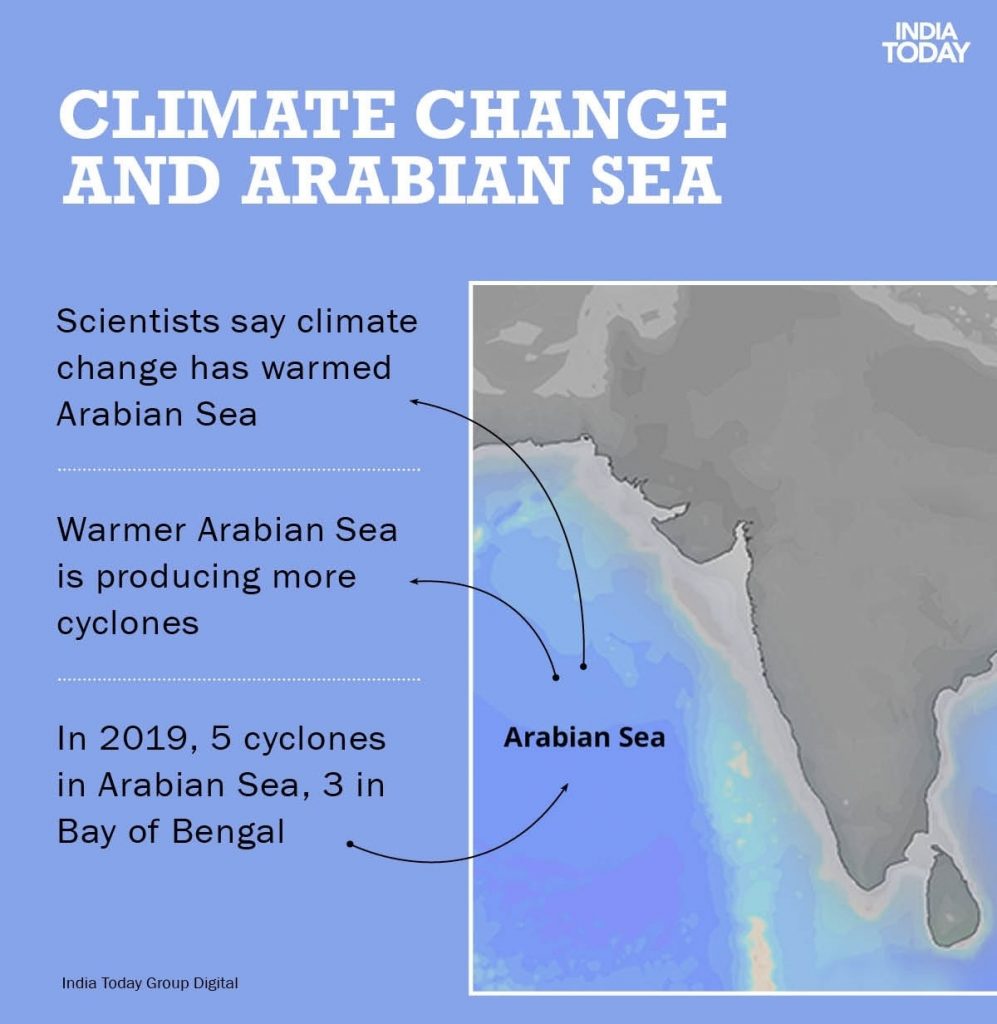Context:
Cyclone Tauktae that was the first Extremely Severe Cyclonic Storm in the Arabian Sea to make landfall in Gujarat in 130 years. In less than a few days after the landfall of Tauktae, there is a possible cyclonic storm in the Bay of Bengal called Yaas.
Relevance:
GS-I: Geography (Physical geography – Climatology, Important Geophysical phenomena), GS-III: Environment and Ecology (Impact of Climate Change), GS-III: Disaster Management
Dimensions of the Article:
- Cyclone Yaas – a possibility
- Increasing numbers of cyclones in changing times
- Bay of Bengal vs Arabian Sea
- Increasing Cyclones in Arabian Sea
Cyclone Yaas – a possibility
- A low-pressure area is likely to form over North Andaman Sea and adjoining east-central Bay of Bengal around May 22, according to the India Meteorological Department (IMD).
- The depression will likely intensify into a cylone and move northwestwards, entering West Bengal and Odisha on May 26.
- Over 800 flood and cyclone shelters in the coastal pockets have been readied to house people from seaside villages in Odisha to deal with the cyclone.
- Odisha will witness a pre-monsoon cyclone for the third year in a row, after Amphan in May 2020 and Fani in May 2019. This is an incremental trend as – Odisha coast faced pre-monsoon cyclones (occurring between April and May) only 14 times since 1804.
Click Here to read more about the Formation of Cyclones
Click Here to read more about the Criteria used for Naming Cyclones
Increasing numbers of cyclones in changing times
- West Indian Ocean normally sees an extremely small number of cyclones and tropical storms compared to the Eastern side. – Between 1891 and 2000, almost 50 tropical cyclones impacted the west coast, of which more than 20 were severe cyclonic storms. In contrast, about 300 cyclones impacted the east coast of the country from the Bay of Bengal, including more than 100 severe cyclonic storms.
- Cyclones occur in the pre-monsoon months of May-June and the post-monsoon months of October-November.
- However, in the past few decades, the average number of storms to occur over the Arabian Sea and the time of the year when they do have both demonstrated a changing trend.
- In 2018, while the Bay of Bengal maintained its average of 4 cyclones a year, Arabian Sea gave rise to 3 instead of 1. A year later in 2019, the Arabian Sea saw 5 cyclones.
- Overall, there was a 32% rise in the number of cyclones between the years of 2014 and 2019.
- The changing trends are consistent with rising temperatures in the Indian Ocean. A 2014 study found that while the temperature of the Indian Ocean rose overall by 0.7 degrees Celsius, the generally colder western Indian Ocean experienced an unexpected warming of 1.2 degrees Celsius in the summer.
- Additionally, cyclones over the Arabian Sea are also increasing in intensity, driven by rising emissions and temperatures.
- Typically, an extremely severe cyclone occurs once every four to five years in the Arabian Sea, however, extremely severe Cyclone Nilofar in 2014 and Chapal and Megh in 2015, formed over the Arabian sea showing the increasing trend.
Bay of Bengal vs Arabian Sea
Near India, cyclones form on either side of the country, but the ones in the Bay of Bengal are more frequent and more intense than in the Arabian Sea.
Why Bay of Bengal creates significantly more cyclones?
- Apart from being a warm pool region, the Bay of Bengal is slightly more landlocked with South East Asian countries surrounding it, compared to the Arabian Sea, which is more expansive and this also leads to an increase in salinity of the seawater.
- The Bay of Bengal is fed by a constant source of freshwater in the form of giant rivers like the Ganga and the Brahmaputra. The river water that empties into the Bay of Bengal warms up at the surface and rises up as moisture. This makes it difficult for the warm layers of water to mix properly with the cooler layers of water below, keeping the surface always warm and ready to feed any potential cyclone over it.
- Furthermore, because of the shape of the land around the Bay of Bengal, the winds are slower and weaker over the ocean, ready to spin.
- According to experts, the Bay of Bengal also gets many remnants of the typhoons in the Pacific Ocean. They come as a low-pressure area into the Bay of Bengal and grow into cyclones due to ideal conditions.

Why are there lesser cyclones in the Arabian Sea?
- The northern, central and western parts of the Arabian Sea have a much cooler temperature. The mountains in east Africa direct winds towards the Arabian Peninsula, dissipating heat much more efficiently throughout the Arabian Sea.
- As a result, this region is not favourable to feed potential cyclones and about half the cyclones that move into this area typically lose energy and dissipate.
Increasing Cyclones in Arabian Sea
- For the past 150-200 years, the Bay of Bengal has given birth to four times more cyclones than the Arabian Sea. But this may soon change, thanks to global warming.
- A study by The Indian Institute of Tropical Meteorology has shown that both the frequency and intensity of cyclones in the Arabian Sea are on the rise. The experts believe the key reason is a rise in the ocean temperature.
- Traditionally, the Arabian Sea is a lot cooler than the Bay of Bengal. But now the Arabian Sea is also becoming a warm pool region because of the additional heat supplied by global warming.

-Source: Down to Earth Magazine



